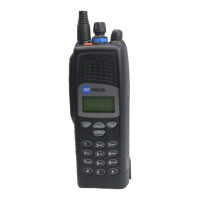248 Transmitter Fault Finding TP9100 Service Manual
© Tait Electronics Limited May 2005
Task 23 —
Check Components
of LPF
If there are no faults in the final RF signal path up to and including the PIN
switch, then the fault should lie in the LPF. Check the LPF as follows:
1. Remove the
PA LPF BOT can.
2. Connect the RF connector to the test set.
3. Check the capacitors and inductors of the LPF between the PIN
switch and the RF connector. See Figure 10.12. Check for shorts,
open circuits, and faulty components. Repair any fault.
4. Enter the CCTM command 326 5 to set the transmitter power level
to the maximum.
5. Enter the CCTM command 101 x x 0, where x is the lowest
frequency (in hertz) for maximum power, as given in Table 10.6
(B1), Table 10.7 (H5), or Table 10.8 (H6).
6. Enter the CCTM command 33 to place the radio in transmit mode.
7. Measure the RF output power. This should exceed 5W.
8. Enter the CCTM command 32 to place the radio in receive mode.
9. Enter the CCTM command 101 x x 0, where x is the highest
frequency (in hertz) for maximum power, as given in Table 10.6
(B1), Table 10.7 (H5), or Table 10.8 (H6).
10. Repeat Step 6 to Step 8.
11. If the power in both the above cases exceeds 5W, the fault has been
rectified; go to “Final Tasks” on page 134. If it does not, the repair
failed; replace the main board and go to “Final Tasks” on page 134.
RF output power: more than 6W (B1), more than 5W (H5, H6)

